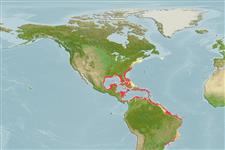Teleostei (teleosts) >
Eupercaria/misc (Various families in series Eupercaria) >
Lutjanidae (Snappers) > Lutjaninae
Etymology: Lutjanus: Malay, ikan lutjan, name of a fish.
More on author: Cuvier.
Environment: milieu / climate zone / depth range / distribution range
Ecology
Marine; brackish; reef-associated; depth range 18 - 70 m (Ref. 9710). Subtropical; 46°N - 26°S, 98°W - 31°W (Ref. 55230)
Western Atlantic: Nova Scotia and Bermuda (Anderson, pers. comm.) to the Amazon, Brazil. Rare north of Florida and apparently rare in the Gulf of Mexico.
Size / Weight / Age
Maturity: Lm ? range ? - ? cm
Max length : 160 cm TL male/unsexed; (Ref. 55); common length : 90.0 cm TL male/unsexed; (Ref. 26938); max. published weight: 57.0 kg (Ref. 9710); max. reported age: 55 years (Ref. 116026)
Dorsal spines (total): 10; Dorsal soft rays (total): 14; Anal spines: 3; Anal soft rays: 7 - 8. Mouth with thick lips. Preopercular notch and knob weak. Scale rows on back rising obliquely above lateral line. Back and sides pale to dark gray with a reddish tinge. The dorsal and caudal fins are grayish; the anal and pelvic fins reddish; the pectoral fins translucent or grayish.
Adults are found mainly around ledges over rocky bottoms or around reefs. Young sometimes inhabit mangrove areas. Maximum depth from Ref. 126840. Feed mainly on fishes, shrimps and crabs (Ref. 55) and lobsters using their strong canines (Ref. 123493). A wary fish, not easily approached underwater (Ref. 13442).
Life cycle and mating behavior
Maturities | Reproduction | Spawnings | Egg(s) | Fecundities | Larvae
Allen, G.R., 1985. FAO Species Catalogue. Vol. 6. Snappers of the world. An annotated and illustrated catalogue of lutjanid species known to date. FAO Fish. Synop. 125(6):208 p. Rome: FAO. (Ref. 55)
IUCN Red List Status (Ref. 130435)
Threat to humans
Reports of ciguatera poisoning (Ref. 55)
Human uses
Fisheries: commercial; gamefish: yes
Tools
Special reports
Download XML
Internet sources
Estimates based on models
Preferred temperature (Ref.
123201): 21.7 - 27.6, mean 25.5 °C (based on 100 cells).
Phylogenetic diversity index (Ref.
82804): PD
50 = 0.5000 [Uniqueness, from 0.5 = low to 2.0 = high].
Bayesian length-weight: a=0.01288 (0.00733 - 0.02265), b=2.99 (2.85 - 3.13), in cm total length, based on LWR estimates for this species & Genus-body shape (Ref.
93245).
Trophic level (Ref.
69278): 4.4 ±0.5 se; based on diet studies.
Resilience (Ref.
120179): Very Low, minimum population doubling time more than 14 years (Preliminary K or Fecundity.).
Fishing Vulnerability (Ref.
59153): Very high vulnerability (83 of 100).
Nutrients (Ref.
124155): Calcium = 10.6 [5.5, 17.3] mg/100g; Iron = 0.27 [0.16, 0.49] mg/100g; Protein = 19.7 [18.1, 21.0] %; Omega3 = 0.179 [0.101, 0.309] g/100g; Selenium = 33 [16, 63] μg/100g; VitaminA = 76.1 [12.6, 374.0] μg/100g; Zinc = 0.225 [0.158, 0.353] mg/100g (wet weight);
